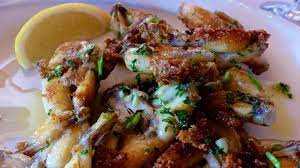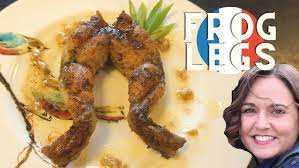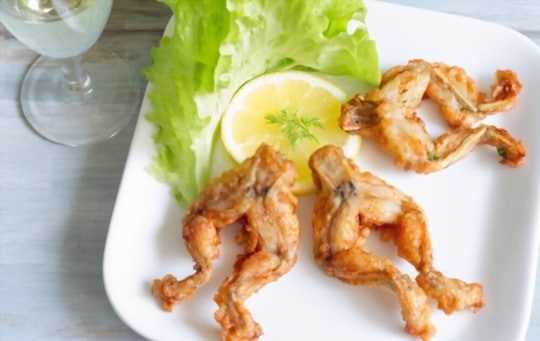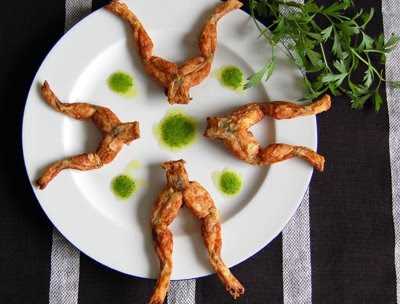
If you’ve never tried frog legs before, you may be missing out on a unique and delicious delicacy. Frog legs are considered a delicacy in many cuisines around the world, and they offer a tender and mildly flavored meat. However, if you’re new to eating frog legs, you may be unsure of how to go about it. Don’t worry, we’ve got you covered!
So, how do you actually eat frog legs? Well, the most common way is to use your hands. Simply pick up a frog leg and start by nibbling the meat off the bone. You can use your teeth to scrape off any remaining meat. The meat of frog legs is tender and delicate, similar to that of chicken or fish, so it usually comes off the bone quite easily.
If you prefer a more refined approach, you can also use a fork and knife to eat frog legs. Start by cutting the meat away from the bone, and then use your fork to pick up bite-sized pieces. This method is especially useful if you’re eating frog legs in a more formal setting.
Why Frog Legs are Considered Delicious
Frog legs, despite being an unconventional food, are considered a delicacy in many cultures around the world. The unique taste and texture of frog legs have made them highly sought after by adventurous eaters and gourmet chefs alike.
One of the main reasons why frog legs are considered delicious is their tender and succulent meat. The meat is firm yet delicate, with a flavor that is often described as a cross between chicken and fish. This combination of flavors makes frog legs versatile and allows them to be prepared in a variety of ways.
Another reason why frog legs are highly regarded in the culinary world is their nutritional value. They are low in fat and calories, while being rich in protein, vitamins, and minerals. This makes them a healthy choice for those looking to incorporate more nutritious foods into their diet.
Frog legs are also prized for their texture. When cooked properly, they can have a crispy exterior while remaining tender and juicy on the inside. This contrast in textures adds to the enjoyment of eating frog legs.
In addition to their taste and texture, frog legs are considered a delicacy because of their cultural significance. In many countries, such as France and China, frog legs have a long-standing tradition as a gourmet dish. They are often associated with upscale dining and are served in fine restaurants.
Overall, the unique flavor, tender texture, nutritional value, and cultural significance of frog legs contribute to why they are considered delicious. Whether you are a fan of exotic foods or simply looking to try something new, frog legs are definitely worth exploring for their gastronomic pleasures.
Choosing the Best Frog Legs
- Consider the source: Buy frog legs from reputable sources to ensure that they are obtained ethically and sustainably. This ensures that you are consuming frog legs that have been harvested in a responsible manner.
- Size matters: Consider the size of the frog legs when making a purchase. Larger legs tend to have more meat and offer a heartier eating experience, while smaller legs are more delicate and tender.
- Look for clean and intact legs: Inspect the legs for any signs of damage or discoloration. The legs should be smooth and free from blemishes or bruising.
- Frozen or fresh: You can choose between frozen or fresh frog legs based on your preferences and availability. Frozen legs are convenient and can be kept for longer periods, while fresh legs offer a more immediate cooking option.
By following these tips, you can ensure that you choose the best frog legs for a delicious and enjoyable eating experience.
How to Eat Frog Legs: A Step-by-Step Guide
Eating frog legs can be a unique and delicious culinary experience. They are considered a delicacy in many parts of the world, and their delicate texture and mild flavor make them a popular choice for adventurous eaters. If you are curious about how to properly prepare and enjoy frog legs, this step-by-step guide will help you discover the best techniques.
1. Choose Fresh Frog Legs
2. Clean and Rinse the Frog Legs

3. Tenderize the Frog Legs
To ensure that the frog legs are tender and succulent, you can tenderize them before cooking. Place the legs in a bowl and sprinkle them with salt and pepper. Let them marinate for at least 30 minutes to help break down any tough fibers.
4. Choose a Cooking Method
There are various cooking methods you can choose from to cook frog legs, depending on your preference. Some popular options include pan-frying, grilling, or baking. Each method offers a different flavor profile and texture, so feel free to experiment and find your favorite.
5. Prepare the Frog Legs for Cooking
Before cooking, it’s essential to prepare the frog legs properly. Pat them dry with a paper towel to remove excess moisture. If you are pan-frying or grilling, you can lightly coat the legs with flour or breadcrumbs to add a crisp texture. If you are baking, brush them with a marinade or sauce of your choice.
6. Cook the Frog Legs
7. Serve and Enjoy
Once the frog legs are cooked to perfection, it’s time to serve and enjoy them. You can serve them as a main dish with a side salad or roasted vegetables, or as an appetizer with a dipping sauce. Garnish with fresh herbs, such as parsley or chives, for added flavor and presentation.
Now that you know the proper techniques for cooking and enjoying frog legs, you can confidently prepare this unique and delicious delicacy. So go ahead, give it a try, and impress your family and friends with your culinary skills!
Top Cooking Techniques for Frog Legs
1. Pan-Seared Frog Legs: Start by rinsing the frog legs thoroughly and patting them dry. Season with salt and pepper. Heat a frying pan over medium-high heat and add a generous amount of butter or oil. Once the fat has melted and is sizzling, carefully add the frog legs to the pan. Cook for 2-3 minutes on each side, until they turn golden brown and crispy. Serve immediately.
2. Grilled Frog Legs: Preheat the grill to medium-high heat. Marinate the frog legs in a mixture of olive oil, lemon juice, garlic, and fresh herbs for at least 30 minutes. Remove the legs from the marinade and pat them dry. Place the legs on the grill, directly over the heat source. Cook for 4-6 minutes per side, turning once, until they are cooked through and charred. Serve with a squeeze of fresh lemon juice.
3. Deep-Fried Frog Legs: Fill a deep pot or fryer with vegetable oil and heat it to 350°F (175°C). In a shallow bowl, whisk together flour, salt, pepper, and any additional seasoning you desire, such as paprika or garlic powder. Take each frog leg and dip it into beaten eggs, then coat it in the flour mixture, pressing lightly to adhere. Carefully place the frog legs in the hot oil and fry for about 4-5 minutes, until they are golden brown and crispy. Drain on paper towels before serving.
4. Baked Frog Legs: Preheat the oven to 400°F (200°C). In a baking dish, arrange the frog legs in a single layer and drizzle them with melted butter or olive oil. Season with salt, pepper, and any desired herbs or spices. Bake for 12-15 minutes, until the meat is opaque and flakes easily with a fork. Serve hot with lemon wedges.
Seasoning and Flavoring Frog Legs
1. Salt and Pepper
The simplest way to season frog legs is with salt and pepper. This classic combination helps to bring out the natural flavors of the meat. Sprinkle a generous amount of salt and pepper on both sides of the frog legs before cooking.
2. Herbs and Spices
Adding herbs and spices to the frog legs can create a more flavorful and aromatic dish. Some popular options include garlic, thyme, rosemary, paprika, and cayenne pepper. You can either sprinkle these directly on the frog legs or create a marinade by mixing the herbs and spices with olive oil or lemon juice.
3. Marinades
Marinating the frog legs can infuse them with additional flavors and tenderize the meat. You can use various ingredients in the marinade, such as soy sauce, vinegar, Worcestershire sauce, honey, and mustard. Allow the frog legs to marinate for at least 30 minutes to overnight, depending on your preference.
4. Citrus Fruits

Using citrus fruits like lemon or lime can add a refreshing and tangy taste to the frog legs. Squeeze the juice of a lemon or lime over the frog legs before cooking or add thin slices of citrus fruits on top for an extra burst of flavor.
Remember, each person’s taste preferences are different, so feel free to experiment with different seasoning and flavoring options to find the combination that suits you best. Don’t be afraid to get creative and try out new flavors to enhance your frog leg dish!
Sides and Accompaniments for Frog Legs
1. Herb-Roasted Potatoes
One classic side dish that pairs well with frog legs is herb-roasted potatoes. The earthy flavors of the potatoes enhance the richness of the meat while providing a satisfying texture. To prepare, simply toss peeled and chopped potatoes with olive oil, minced garlic, fresh herbs like rosemary and thyme, and salt and pepper. Roast in the oven until golden and crispy.
2. Grilled Vegetables
Grilled vegetables make for a light and refreshing accompaniment to frog legs. Asparagus, zucchini, bell peppers, and carrots can be brushed with olive oil, seasoned with salt and pepper, and grilled until tender. The smoky char adds depth to the overall flavor profile.
3. Fresh Green Salad
A fresh green salad can provide a contrast to the rich flavor of the frog legs. Choose a mix of greens like arugula, spinach, and spring mix, and toss with a light vinaigrette. You can also add some sliced cherry tomatoes, cucumber, and thinly sliced red onions for added freshness.
4. Garlic Butter Rice
Garlic butter rice is a versatile and flavorful option that pairs well with frog legs. Prepare your favorite rice, whether it’s white, jasmine, or basmati, and cook it according to the package instructions. In a separate pan, melt butter and sauté minced garlic until fragrant. Stir the garlic butter mixture into the cooked rice and season with salt and pepper to taste.
5. Crispy Onion Rings

The crispy texture of onion rings can be a delicious contrast to the tender frog legs. Dip sliced onions in a batter made of flour, buttermilk, eggs, paprika, and salt. Fry them until golden brown and crispy. Serve alongside the frog legs for a satisfying crunch.
Remember to choose sides and accompaniments that complement the flavors and textures of the frog legs. Experiment with different combinations to find your favorite pairing and enhance your enjoyment of this unique and delicious dish.
| Sides and Accompaniments | Recommended Dish |
|---|---|
| Herb-Roasted Potatoes | Classic and savory |
| Grilled Vegetables | Light and flavorful |
| Fresh Green Salad | Refreshing and crisp |
| Garlic Butter Rice | Rich and aromatic |
| Crispy Onion Rings | Crunchy and satisfying |
Eating Frog Legs: Tips for How to Enjoy this Unique Delicacy
- Choose high-quality frog legs: When buying frog legs, ensure they are fresh, free of blemishes, and sourced from reputable suppliers. Fresh frog legs should have a mild odor and a vibrant, translucent flesh.
- Properly clean and prepare the legs: Before cooking, clean the legs thoroughly to remove any excess blood or debris. Trim away any excess fat or membrane for a more refined appearance.
- Experiment with different cooking techniques: Frog legs can be prepared using various methods, such as frying, grilling, baking, or sautéing. Each technique offers a unique texture and taste, so don’t be afraid to try different recipes to find your favorite.
- Season and flavor: Frog legs have a mild flavor that pairs well with a range of spices and seasonings. Consider marinating them in a mixture of herbs, garlic, lemon juice, and olive oil for added flavor. Alternatively, coat them in breadcrumbs or spices before cooking for a crispy and tasty outer layer.
- Present the frog legs beautifully: Presentation plays a vital role in enhancing the dining experience. Consider arranging the cooked frog legs on a bed of fresh greens, garnishing with lemon slices, and adding a sprinkle of chopped herbs for an elegant and visually appealing presentation.
- Pair with the perfect drink: To complete your meal, select a drink that complements the flavors of the frog legs. White wines, such as Chardonnay or Sauvignon Blanc, or light beers make excellent choices. Alternatively, for non-alcoholic options, consider pairing with a crisp apple cider or a citrus-infused mocktail.
- Where to find and buy frog legs: Frog legs can be found at specialty seafood markets, gourmet food stores, or online suppliers. Make sure to check local regulations and ensure that the frog legs are sourced from sustainable and responsible sources.
By following these tips, you can maximize your enjoyment of frog legs and create a memorable dining experience. So, don’t hesitate to embrace the unique flavors and textures that this delicacy has to offer and savor every bite!
Pairing Drinks with Frog Legs
Here are some tips on how to pair drinks with frog legs:
1. White Wine
2. Beer
If you prefer beer over wine, there are several options that can go well with frog legs. Light and crisp beers such as pilsners or lagers can provide a refreshing contrast to the richness of the meat. Alternatively, a hoppy IPA can add a citrusy and bitter note to the dish.
3. Cocktails
If you’re feeling adventurous, you can also pair frog legs with cocktails. A citrusy cocktail such as a mojito or a margarita can complement the flavors of the dish and provide a refreshing and zesty accompaniment.
4. Sparkling Water
If you prefer a non-alcoholic option, sparkling water can be a great choice. The effervescence and clean taste can cleanse your palate between each bite of the frog legs, allowing you to fully savor the flavors.
Remember to experiment with different drinks to find your preferred pairing. Ultimately, the goal is to find a beverage that enhances the flavors of the frog legs and provides a pleasurable dining experience.
| Best Drinks for Pairing with Frog Legs |
|---|
| White Wine (Sauvignon Blanc or Chardonnay) |
| Beer (Pilsners or Lagers, IPA) |
| Cocktails (Mojito, Margarita) |
| Sparkling Water |
So, the next time you’re enjoying a plate of deliciously cooked frog legs, don’t forget to pair them with the perfect drink for a truly enjoyable culinary experience.
Where to Find and Buy Frog Legs
If you’re wondering where to find and buy frog legs, look no further! There are several places where you can purchase these delectable delicacies.
1. Seafood Markets: Many seafood markets carry fresh or frozen frog legs. These markets specialize in a wide variety of seafood options and are likely to have frog legs available. Make sure to check their seafood section or inquire with the staff.
2. Gourmet Food Stores: High-end gourmet food stores often stock frog legs as a unique choice for adventurous food lovers. These stores usually have a well-curated selection of specialty foods, including exotic meats like frog legs.
4. Online Retailers: There are numerous online retailers that specialize in selling frog legs. With just a few clicks, you can have frog legs delivered right to your doorstep. Look for reputable online sellers that guarantee the quality and freshness of their products.
5. Local Restaurants: Some restaurants, especially those specializing in seafood or international cuisines, may have frog legs on their menu. If you want to try frog legs cooked by the experts, visiting a local restaurant can be a great option.
Before making a purchase, ensure that the frog legs are sourced ethically and sustainably. Look for suppliers that follow responsible fishing and farming practices to support ecological balance.

I’m Lena Adams—a product of an unconventional upbringing in the African wilderness. My father, a daring explorer of African wildlife, sparked my fascination with reptiles, a passion that intertwined with the tragic loss of my mother during an expedition, leaving an indelible mark on my life. Driven to understand the creatures that captivated my parents, I embarked on my journey, sharing insights about reptiles, frogs, and lizards on my website. Through my explorations and conservation efforts, I honour my family’s legacy while seeking connections—to the creatures, nature, and the mother whose presence I yearn to understand.
